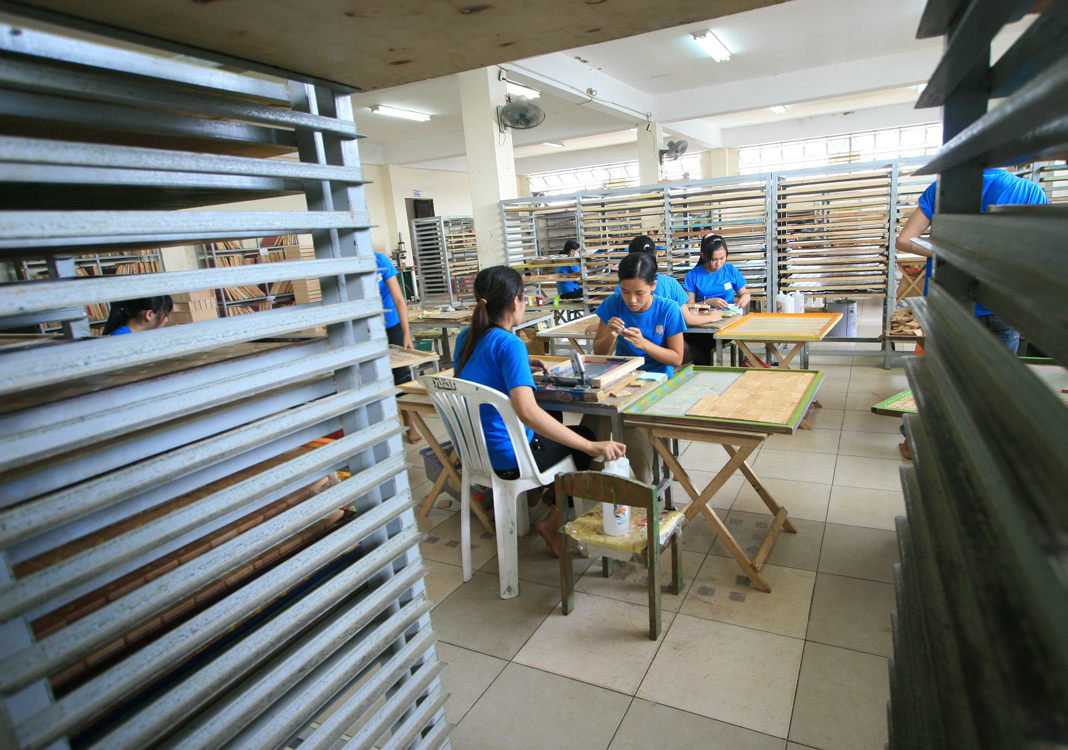Despite the ravages of Covid-19, Vietnam’s woodworking industry has posted a two-digit growth rate and climbed three notches in the list of countries earning remarkable wood product export sales, trailing only China. However, concerns over the coming time still linger.
Last year, plagued by customers’ requests of cancelling or halting their orders due to Covid-19, plenty of wood processing enterprises in Vietnam encountered difficulties. As these customers are from the major markets in the America and Europe, undelivered products stockpiled in warehouses of local wood enterprises. At present, nevertheless, the domestic woodworking sector has regained its growth momentum, even surpassing that prior to the pandemic.
 Strong export increase
Strong export increase
Nguyen Van Sang, director of Viet Products Corp., the owner of the Furnist store chain, says his company has won enough orders from American and European customers for production until the end of this year. Viet Products has also clinched new clients from the United States, which contributed some 30% to the company’s growth compared with the same period in 2019. According to Mr. Sang, these new customers once placed their orders with Chinese partners.
According to Nguyen Chanh Phuong, vice chairman of the Handicraft and Wood Industry Association of HCMC (HAWA), many of his members have also received orders which will help them sustain production until the end of the year, or at least till the end of the third quarter. Similarly, several members of the Binh Duong Furniture Association (BIFA) have also received requests which will last for six months to one year, says Dien Quang Hiep, chairman of BIFA and general director of Minh Phat 2 Indoor Furniture and Sofa Co. (Mifaco).
Mr. Hiep explains that the woodworking industry posted a growth rate between 15% and 20% before the pandemic. Fortunately, despite a slump in the first half of 2020, the sector regained growth thanks partly to the social distancing scheme, when the demand for home decoration rose since everybody had to stay at home. In addition, importers shifted their orders from China to Vietnam to avoid high taxes imposed by the U.S. on wood products imported from China. Mr. Hiep says China is the world’s biggest wood product exporter, with export turnover way higher than Vietnam’s, which means just a small part of her orders shifted to Vietnam may make local producers work at full capacity.
Those reasons explain why the export turnover in the woodworking industry rose by 16.4% in 2020 and exceeded the year’s target by 5.4%. Statistics released by the Center for Industrial Studies (CSIL, Italy) show that Vietnam has surpassed Poland, Germany and Italy in the ranking of leading wood product exporting countries, behind only China.
Data obtained from the General Department of Vietnam Customs show that the country’s woodwork export sales in the first quarter of this year reached about US$3.69 billion, up 41.5% year-on-year. Moreover, the advantage of Vietnam’s wood products is rising in the U.S. market, which accounts for over 50% of the total export value of the entire sector.
Concerns remain
The surge in exports to the U.S. market, according to observers, may give rise to preventive trade measures from the American side, especially after her relevant agencies have paid special attention to investment and trading activities with signs of fraud. In reality, many are concerned about the fact that Vietnam’s woodworking sector is becoming a destination for investment frauds and commercial risks.
There have been cases in which Chinese investors hired workshops, workers and managers in Vietnam. They imported wooden parts from China for assembly in Vietnam and exported products with Vietnamese origin. Some Chinese-invested companies even shipped in wood products from China and then exported them stateside. Several foreign investors have acquired local wood processing firms.
Representatives of both HAWA and BIFA say to have compelling evidence of fraud or illegal investment, there should be investigations from relevant agencies, authorities and businesses in the industry. Warnings have been made that Vietnam might become a transit point for exports and a victim of commercial sanctions in international trade relations. Therefore, in the context of the increased foreign investment in the woodworking industry, investment licensing and supervision of foreign-invested enterprises must be strictly observed.
Another concern comes from the increase in wood import from Africa. Those wood imports have competitive prices. However, their information and traceability are not available to both sellers and buyers. This is an obstacle to the observation of the regulations pertaining to the legality of wood stipulated in the VPA/FLEGT Agreement (Voluntary Partnership Agreement/Forest Law Enforcement, Governance and Trade) between Vietnam and the European Union. Moreover, natural resource management policies of some African countries are lax, inconsistent and even contradictory, which might further expose wood from these sources to legal risks.
As regards the export structure, that fact that only 653 foreign-invested enterprises (FIEs) export wood products (18%) but they account for 51% of the total export turnover of the whole sector indicates that FIEs have fared much better than their local counterpart when it comes to scale and added value.
In addition, other difficulties of the woodworking industry need to be tackled by more adequate and sustainable measures. Apart from the shortage of human resources, high space rentals make it hard for businesses to expand production.
Some have opined that most of the value of Vietnam’s wood processing industry comes from the manufacturing phase with low added value. To obtain the export target of US$20 billion by 2025, wood exporters should no longer depend only on the value created solely by the manufacturing phase as it is increasingly more difficult to expand production scale while cheap labor has lost much of the advantage.
By Quoc Hung









